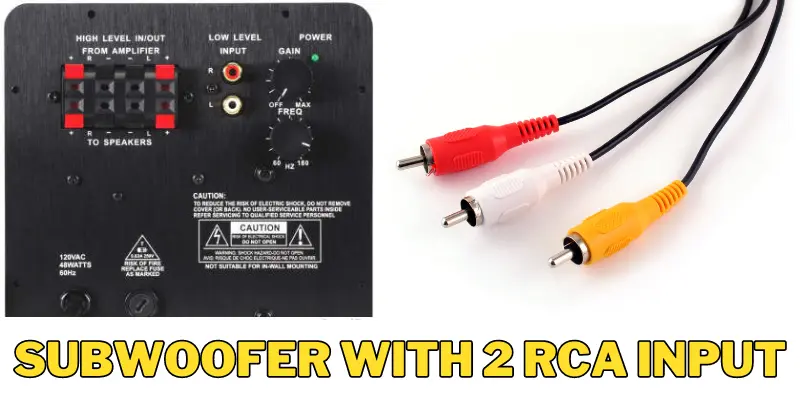
In audio setups, a subwoofer plays a vital role in delivering those deep, rumbling bass notes that add depth and dimension to your sound experience. However, what if your receiver lacks a designated subwoofer output, leaving you pondering the connection puzzle?
Fret not, for there are ingenious solutions at your disposal. I’m here to guide you through the process of seamlessly connecting a subwoofer to your receiver, even in the absence of a dedicated subwoofer output.
If you want to connect a subwoofer output, connect the subwoofer to the receiver’s preamp outputs using RCA cables.
In this article, I’ll guide you on how to connect subwoofer to receiver without subwoofer output, what alternatives are, whether you can use different cables to connect subwoofer, what they are the receiver settings and tips to improve bass performance.
Do you also want to know how long your subwoofer will last? If you take good care of your subwoofer, your subwoofer can easily last seven to twenty years.
Key Takeaways
- Subwoofers enhance audio with deep bass, even if your receiver lacks a dedicated subwoofer output.
- Use RCA cables or line-level converters to connect subwoofers without specific outputs.
- Transform a passive subwoofer with a mini amplifier or direct wiring.
- Utilize different cable types, like speaker wires, Y-adapters, or converters, for versatile connections.
- Adjust receiver settings and explore “LFE+MAIN” to optimize subwoofer integration.
- Place subwoofers thoughtfully and set speakers to “Small” for better bass performance.
- Quality bass matters: prioritize clarity over excessive muddled thumping.
- Check subwoofer capabilities and receiver inputs to find the best connection method.
- Amplifiers, Y-cables, and converters provide solutions for passive subwoofers without proper outputs.
- Key Takeaways
- How to connect subwoofer to receiver without subwoofer output?
- Can I use a different type of cable to connect a subwoofer to my receiver without a subwoofer output?
- Are there any adapters or converters available for connecting a subwoofer to a receiver without the proper output?
- Do I need to adjust any settings on my receiver when connecting a subwoofer without a dedicated output?
- Are there any tips for improving bass performance when my receiver doesn't support a subwoofer?
- FAQs
- What if my receiver doesn't have a designated subwoofer output?
- Can I connect a passive subwoofer to a receiver without a mini amplifier?
- How can I convert speaker wire signals into a format my subwoofer understands?
- Are there alternatives to using RCA cables for connecting a subwoofer?
- How can I optimize bass performance if my receiver doesn't support a subwoofer?
- What's the "LFE+MAIN" setting on a subwoofer?
- Conclusion:
How to connect subwoofer to receiver without subwoofer output?

Sure thing, I’m here to guide you through connecting a subwoofer to a receiver, even if it doesn’t have a dedicated subwoofer output. You might be wondering, “How can I make this work?” Well, I’ve got your back. Let’s dive into the options.
First, if your subwoofer comes with RCA input jacks, that’s your ticket. Just find those jacks on the subwoofer; if they’re there, you’re in business. Plug them into the corresponding RCA output on your receiver. Simple as that.
Let’s say your subwoofer isn’t playing nice with RCA inputs. No worries, we’ve got another play. Look for speaker-level inputs on your subwoofer. If they’re available, you can use them.
Run the speaker wires from your receiver’s speaker outputs to these inputs on the subwoofer. You might be thinking, “Why would I do that?” Well, it’s a way for your subwoofer to catch the same vibe as your main speakers.
Hold on, we’re not done yet. If you’re rolling with a passive subwoofer, here’s the deal. You can team it up with a mini amplifier. This little guy bridges the gap between your subwoofer and the receiver. Connect the subwoofer to the mini amp, and then hook up the mini amp to the receiver. It’s like being the matchmaker of audio.
But wait, there’s more. If your subwoofer is passive, and you don’t have a mini amp, you can wire it directly. Take the receiver’s speaker outputs and hook them straight to the subwoofer. No middleman is needed.
Read More: How to Hide Subwoofer
Now, let’s be real here – the kind of subwoofer you’ve got, the inputs and outputs it flaunts, and what your receiver brings to the table will be the deciders here. You’re letting them have a say in your setup’s fate.
Do you have an RCA jack on your sub? Sweet. But if that’s not happening, don’t worry. There’s this thing called a line-level converter. It takes speaker wire vibes from your receiver and translates them into a language your subwoofer understands. Plug it in, let it work its magic.
Don’t let your receiver’s subwoofer output no-show bum you out. There’s a workaround. Sneak a peek at the preamp output on your stereo receiver’s backside. That might just be your golden ticket to subwoofer town.
To wrap things up, you’ve got a bunch of tricks up your sleeve for connecting that subwoofer to your receiver sans a dedicated subwoofer output. The winning move? It depends on the pieces of gear you’re playing with.
Dive into sources like SoundCertified, Loyal Audio and BoomSpeaker for more nitty-gritty details and visuals on nailing these connections.
If your subwoofer is making distorted sound, don’t worry there is a very easy fix. First, reduce the sound volume of your subwoofer, if it still doesn’t work, install an amplifier according to the power of the subwoofer.
Read More: How to Fix Subwoofer Distortion
Can I use a different type of cable to connect a subwoofer to my receiver without a subwoofer output?

Yes, you can use different types of cables to connect a subwoofer to a receiver without a subwoofer output. One way is to use a speaker wire to enable your subwoofer to act as a speaker.
It’s one of the easiest ways to connect your subwoofer to your receiver without a subwoofer output. It would be best to use the front and proper speaker terminals to achieve this.
Run your speaker wires to join the subwoofer to the receiver, connect the wire to the left and right receiver’s speaker terminal, connect the right and left speakers to the subwoofer’s speaker terminal, check your connections, and start your audio. This option will work if your subwoofer has speaker-level capabilities.
Another way is to set up the preamp output. You can connect with the preamp out if your receiver lacks the subwoofer output. This jack is behind the amp/receiver on the connection board.
Check the receiver’s rear panel to see whether you can see ‘pre-out.’ Use a couple of interconnects from the receiver to your sub if you find it. If the receiver has a single RCA input, add a Y adapter. Check each of your connections and power on your audio system.
If your subwoofer has at least one RCA jack, you can connect it to your receiver without a sub-output using a line-level converter. These converters accept speaker wire connections and scale down the speaker level signal to the kind your subwoofer can take.
You can also use an amplifier or Y-cables with a passive subwoofer. If you use an amplifier, connect the amp’s outputs to the subwoofer’s inputs, then connect the amp’s power cord to an outlet.
If you wanna get good performance from your subwoofer, then you have to install a box on your subwoofer. Do you want to know more about that do subwoofer need a box, I have already uploaded article on it. You can read it.
Are there any adapters or converters available for connecting a subwoofer to a receiver without the proper output?
You can use different cable options when connecting a subwoofer to your receiver without that dedicated subwoofer output. I’m here to walk you through the steps, so let’s dive in.
I’ll teach you a fantastic method – utilizing a simple speaker wire – to turn your subwoofer into a speaker itself. Trust me, it’s a breeze and among the easiest ways to get your subwoofer hooked up to the receiver without that specialized output. Here’s what you have to do:
- Make friends with the front and suitable speaker terminals.
- Connect your subwoofer and receiver by running those speaker wires.
- Link the receiver’s left and right speaker terminals, hook up your speakers to the subwoofer’s speaker terminal, double-check the connections, and hit play.
This trick’s golden if your subwoofer can handle speaker-level magic.
Now, let’s talk about another option: fret not if your receiver isn’t throwing out a subwoofer output. You have a friend named ‘Preamp Output’ to the rescue. Here’s your next move: Find that connection board at the back of your amp or receiver.
Scout for the term ‘pre-out.’ Found it? Excellent. Now, grab a couple of interconnects and create a bridge between your receiver and the sub. And if your receiver’s got a single RCA input, add a Y adapter. Double-check the connections before you hit the power switch for your audio fix.
Hold on, there’s more in store. Did you get a subwoofer that boasts at least one RCA jack? Then listen up. Using a trusty line-level converter, I’ll show you how to link it to your receiver sans sub-output.
Think of these converters as interpreters for your subwoofer’s language. They’ll transform those speaker wire vibes into a signal your subwoofer understands.
Read More: Can a Subwoofer break Glass
Oh, and let’s not forget about passive subwoofers. If you’ve got one, here’s your game plan. You can either roll with an amplifier or go the Y-cable route. Amp time? Super easy.
Connect the amp’s outputs to the subwoofer’s inputs and plug in the amp’s power cord—done deal. And if Y-cables are more your style, distribute the connection love between your receiver and subwoofer.
So there you go, step by step. Armed with these methods, you can bridge the gap between your subwoofer and receiver, even without a designated subwoofer output. Just follow my lead and let the audio magic flow!
Read More: Best Subwoofer under 500
Do I need to adjust any settings on my receiver when connecting a subwoofer without a dedicated output?
It’s time to fine-tune those receiver settings for that subwoofer, even if it doesn’t come with its own designated output. Let me guide you through these steps.
I’ll break it down for you: Once you’ve the physical connections, here’s what you must do. Fire up your AV receiver and preamp. Dive into the receiver’s menu settings because that’s where the magic happens.
Look for the Zone 2 output configuration. Pick your desired audio sources and tweak any settings that need attention, like adjusting those volume levels and tone controls.
Here’s a neat trick: If you’re aiming to unite your subwoofer with a receiver that’s not giving you that dedicated output, you might want to set that subwoofer to ‘LFE+MAIN.’ Check out your amp’s subwoofer settings – that’s where you’ll find the answers.
This ‘Crossover LFE+Main’ setting works wonders. It cooks up deep, earth-shaking bass below the crossover points for both your subwoofer and speakers. It’s a go-to in many sound systems.
And there you have it, a handful of ways to tweak those receiver settings when joining your subwoofer to the mix without a specific output. Follow these steps, and you’ll have that audio setup dancing to your tunes in no time!
Read More: Best Subwoofer under 200
Are there any tips for improving bass performance when my receiver doesn’t support a subwoofer?
Let me share some smart tips to boost your bass performance, even if your receiver isn’t precisely subwoofer-friendly. I’ll break it down so you know exactly what to do.
First, here’s a key move: Make sure your front speakers – or the entire system – are switched to “Small” in those receiver settings. Trust me, this minor tweak can make a big difference. If your speakers are set to “Large” or “Full Range,” they’ll hog all that low-frequency goodness instead of letting the subwoofer shine.
Now, onto placement – a game-changer. Correctly positioning your subwoofer is like hitting the sweet spot. You have to pay attention to this, seriously.
While bass waves below 80Hz don’t have a direction you can pinpoint, where you place the subwoofer in the room can completely change the game. It affects how it booms in your space and reaches your ears at the listening spot.
But hold up, we’re not just about quantity; we’re all about quality. Sometimes, leaner bass that’s clean and snappy beats a heavy dose of muddled thump. If your bass lacks clarity, it’s better to tone it down.
Muddy bass is a no-go, my friend. When your bass isn’t up to par, it’s a constant reminder that you’re not getting that authentic sound experience you crave.
So, remember these tactics: Set those speakers to “Small,” find that perfect subwoofer spot, and prioritize crisp, precise bass. Stick to these steps, and that bass will hit all the right notes, regardless of your receiver’s limitations.
Read More: Can you use a Subwoofer in an Apartment
FAQs
What if my receiver doesn’t have a designated subwoofer output?
No worries! There are ingenious solutions, such as using RCA cables, speaker wires, or converters, to connect a subwoofer to your receiver seamlessly.
Can I connect a passive subwoofer to a receiver without a mini amplifier?
Absolutely! You can directly wire the passive subwoofer by connecting the receiver’s speaker outputs to the subwoofer’s inputs.
How can I convert speaker wire signals into a format my subwoofer understands?
A line-level converter is your solution. It translates speaker wire vibes from your receiver into a language your subwoofer can interpret.
Are there alternatives to using RCA cables for connecting a subwoofer?
Yes, you can use speaker wires or even set up with the preamp output, depending on your subwoofer’s capabilities and the receiver’s inputs.
How can I optimize bass performance if my receiver doesn’t support a subwoofer?
Start by ensuring your front speakers are set to “Small” in receiver settings, and position your subwoofer thoughtfully for better bass distribution.
What’s the “LFE+MAIN” setting on a subwoofer?
This setting combines low-frequency effects (LFE) with the main speakers’ audio, creating a richer bass experience for your subwoofer and speakers.
Conclusion:
In audio, a subwoofer’s resonant bass adds depth to your sound. Yet, what if your receiver lacks a subwoofer output? Fear not, solutions abound. Whether using RCA cables, speaker wires, or converters, I’ve guided you through seamless connections.
If you have any questions about how to connect subwoofer to receiver without subwoofer output, you can ask me through the comment section. If you have liked this article, please share it with your friends.
Read More Our Articles:






